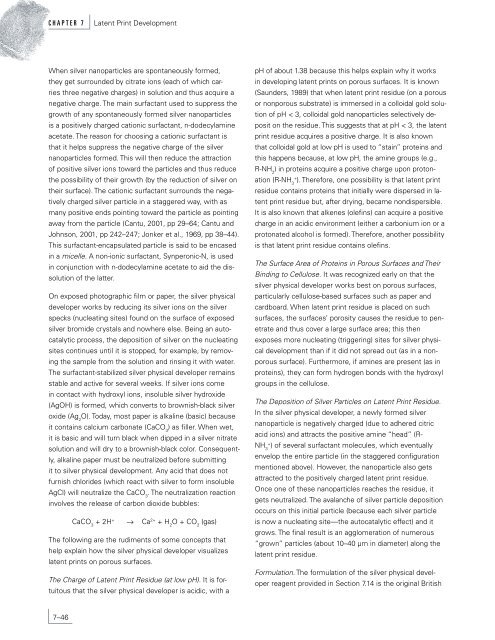Latent Print Development - National Criminal Justice Reference ...
Latent Print Development - National Criminal Justice Reference ...
Latent Print Development - National Criminal Justice Reference ...
You also want an ePaper? Increase the reach of your titles
YUMPU automatically turns print PDFs into web optimized ePapers that Google loves.
C H A P T E R 7 <strong>Latent</strong> <strong>Print</strong> <strong>Development</strong><br />
When silver nanoparticles are spontaneously formed,<br />
they get surrounded by citrate ions (each of which carries<br />
three negative charges) in solution and thus acquire a<br />
negative charge. The main surfactant used to suppress the<br />
growth of any spontaneously formed silver nanoparticles<br />
is a positively charged cationic surfactant, n-dodecylamine<br />
acetate. The reason for choosing a cationic surfactant is<br />
that it helps suppress the negative charge of the silver<br />
nanoparticles formed. This will then reduce the attraction<br />
of positive silver ions toward the particles and thus reduce<br />
the possibility of their growth (by the reduction of silver on<br />
their surface). The cationic surfactant surrounds the negatively<br />
charged silver particle in a staggered way, with as<br />
many positive ends pointing toward the particle as pointing<br />
away from the particle (Cantu, 2001, pp 29–64; Cantu and<br />
Johnson, 2001, pp 242–247; Jonker et al., 1969, pp 38–44).<br />
This surfactant-encapsulated particle is said to be encased<br />
in a micelle. A non-ionic surfactant, Synperonic-N, is used<br />
in conjunction with n-dodecylamine acetate to aid the dissolution<br />
of the latter.<br />
On exposed photographic film or paper, the silver physical<br />
developer works by reducing its silver ions on the silver<br />
specks (nucleating sites) found on the surface of exposed<br />
silver bromide crystals and nowhere else. Being an autocatalytic<br />
process, the deposition of silver on the nucleating<br />
sites continues until it is stopped, for example, by removing<br />
the sample from the solution and rinsing it with water.<br />
The surfactant-stabilized silver physical developer remains<br />
stable and active for several weeks. If silver ions come<br />
in contact with hydroxyl ions, insoluble silver hydroxide<br />
(AgOH) is formed, which converts to brownish-black silver<br />
oxide (Ag O). Today, most paper is alkaline (basic) because<br />
2<br />
it contains calcium carbonate (CaCO ) as filler. When wet,<br />
3<br />
it is basic and will turn black when dipped in a silver nitrate<br />
solution and will dry to a brownish-black color. Consequently,<br />
alkaline paper must be neutralized before submitting<br />
it to silver physical development. Any acid that does not<br />
furnish chlorides (which react with silver to form insoluble<br />
AgCl) will neutralize the CaCO . The neutralization reaction<br />
3<br />
involves the release of carbon dioxide bubbles:<br />
CaCO 3 + 2H + → Ca 2+ + H 2 O + CO 2 (gas)<br />
The following are the rudiments of some concepts that<br />
help explain how the silver physical developer visualizes<br />
latent prints on porous surfaces.<br />
The Charge of <strong>Latent</strong> <strong>Print</strong> Residue (at low pH). It is fortuitous<br />
that the silver physical developer is acidic, with a<br />
7–46<br />
pH of about 1.38 because this helps explain why it works<br />
in developing latent prints on porous surfaces. It is known<br />
(Saunders, 1989) that when latent print residue (on a porous<br />
or nonporous substrate) is immersed in a colloidal gold solution<br />
of pH < 3, colloidal gold nanoparticles selectively deposit<br />
on the residue. This suggests that at pH < 3, the latent<br />
print residue acquires a positive charge. It is also known<br />
that colloidal gold at low pH is used to “stain” proteins and<br />
this happens because, at low pH, the amine groups (e.g.,<br />
R-NH ) in proteins acquire a positive charge upon proton-<br />
2<br />
+ ation (R-NH ). Therefore, one possibility is that latent print<br />
3<br />
residue contains proteins that initially were dispersed in latent<br />
print residue but, after drying, became nondispersible.<br />
It is also known that alkenes (olefins) can acquire a positive<br />
charge in an acidic environment (either a carbonium ion or a<br />
protonated alcohol is formed). Therefore, another possibility<br />
is that latent print residue contains olefins.<br />
The Surface Area of Proteins in Porous Surfaces and Their<br />
Binding to Cellulose. It was recognized early on that the<br />
silver physical developer works best on porous surfaces,<br />
particularly cellulose-based surfaces such as paper and<br />
cardboard. When latent print residue is placed on such<br />
surfaces, the surfaces’ porosity causes the residue to penetrate<br />
and thus cover a large surface area; this then<br />
exposes more nucleating (triggering) sites for silver physical<br />
development than if it did not spread out (as in a nonporous<br />
surface). Furthermore, if amines are present (as in<br />
proteins), they can form hydrogen bonds with the hydroxyl<br />
groups in the cellulose.<br />
The Deposition of Silver Particles on <strong>Latent</strong> <strong>Print</strong> Residue.<br />
In the silver physical developer, a newly formed silver<br />
nanoparticle is negatively charged (due to adhered citric<br />
acid ions) and attracts the positive amine “head” (R-<br />
+ NH ) of several surfactant molecules, which eventually<br />
3<br />
envelop the entire particle (in the staggered configuration<br />
mentioned above). However, the nanoparticle also gets<br />
attracted to the positively charged latent print residue.<br />
Once one of these nanoparticles reaches the residue, it<br />
gets neutralized. The avalanche of silver particle deposition<br />
occurs on this initial particle (because each silver particle<br />
is now a nucleating site—the autocatalytic effect) and it<br />
grows. The final result is an agglomeration of numerous<br />
“grown” particles (about 10–40 μm in diameter) along the<br />
latent print residue.<br />
Formulation. The formulation of the silver physical developer<br />
reagent provided in Section 7.14 is the original British

















